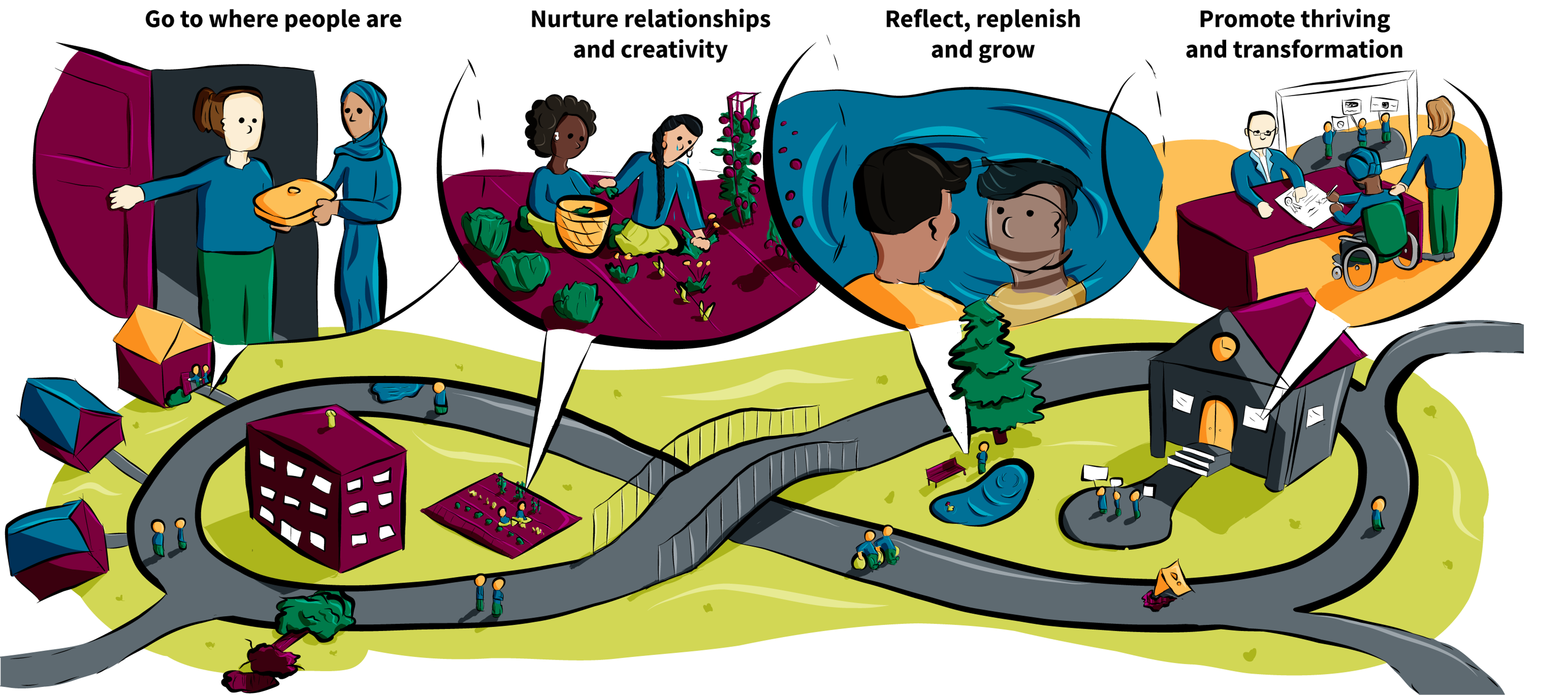6 Ambassador Skills
Practically, what does this mean for you as an EqCC Ambassador?
Acting as an EqCC Ambassador will look differently for different people. To provide some structure to what your practical next steps may look like, we describe below a model for engaging in EqCC work. In the image below, there is an infinity loop pathway at the centre that is designed to illustrate how EqCC is dynamic, continuous, and rooted in a community ecosystem that can create a grass-roots social movement for transformation. The infinity loop illustrates individuals and groups of people who are embedded in distinct, but connected, micro and macro environments, and have opportunities to come together, leave the path and return. There are barriers along the path representing the mistakes, harms, and pitfalls that frequently occur in co-creation work, necessitating the constant need for reflexivity, feedback, and ongoing learning. The infinity loop reminds us that it may take time for change to happen, which requires sustained momentum and accountability. The ‘call-out’ images along the pathway represent the four cross-cutting themes or processes embedded in equity-based cocreation. These elements represent imperatives in enacting co-creation processes that are inclusive and accessible to those who may face a range of structural inequities. Ultimately the relationships, skills, and knowledge built in one environment can be galvanized to create change in new environments, building towards systemic change in structures, policies, governance.
Go to where people are
Overall, this theme highlights that entry should only be granted when the community feels connected to the researcher and the issue, with a readiness to be receptive and willing to engage in the co-creation and change. All co-creation participants should be invited to examine and identify their purpose, passion, and commitment to sustainable change from the outset of a project. The idea of ‘going to community’ highlights that EqCC needs to occur where people are in their communities (e.g., homes, libraries, cafes, gardens, hairdressers).
Nurture relationships and creativity
This second theme emphasizes that effort is needed to create and nurture an optimal environment for creativity and relationship building. There is value in ample opportunities to observe and listen, build rapport, ask questions, and engage in experiential learning. This suggests that everyone must enter this space with an openness to learning and curiosity.
Reflect, replenish, and grow
EqCC benefits from the presence of a “constant gardener” as someone who could provide information about the ongoing and historical harms within a community; part of the preconditions required to reflect, replenish and grow. Before work begins, it was emphasized that co-creation participants should reflect, acknowledge harm, grieve, and be aware of the potential for introducing or reinforcing harms. Co-creation processes can be exhausting, however, rain may flow via tears and stories to replenish the soil and create fertile ground for co-creation.
Promoting thriving and transformation
There are three elements that combine to create a vision for thriving and transformation, these include: consideration for who is engaged in the change, the processes by which thriving and transformation occur, and the impacts that can be achieved. Building from the ground up creates a new workforce that promotes the redistribution of power and recognition of new leaders that can affect change at multiple levels of the ecosystem. These changes do not occur solely by opening doors for new people, they also require advocacy in challenging traditional systems and structures. Each win at the micro, meso, and macro levels serves to build momentum allowing for mutual reinforcement and a groundswell that promotes maximum impact.
Case Study: What’s best for Esther?
Questions to Consider:
- Describe why the Esther Network would be considered an equity-based co-creation effort.
- What questions might you ask an Esther to learn about their positionality? (identify 5-10)
- Considering your own positionality, describe how you might be support an Esther as an ally.


